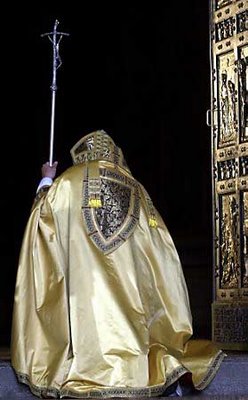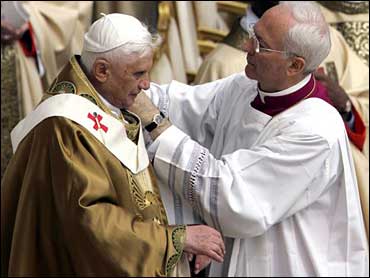Forgive me for being in partial reruns this week.... To use TV-speak, last week was "Sweeps Week" (or the Olympics), and this week I'm just trying to catch a breather inbetween everything else going on. But this is something which newer readers, who haven't seen it previously, might enjoy.
One thing Catholic which continues to fascinate the wider audience -- always a surefire conversation-starter in church circles -- is the future of the Jesuits. And possibly my favorite piece of all of the 1,600 or so I've written for these pages was published at the end of January, as speculation surrounded the potential retirement of Fr Peter-Hans Kolvenbach as Superior of the Society of Jesus at a General Convention to be convoked in 2008.
The Jesuit General, often called the "Black Pope" has, with but one exception, served for life. Given that reality, talk of Kolvenbach's early departure stirred the pot among his confreres and in circles throughout the wider church.
Five days after the piece originally ran, the 35th General Congregation of the Society was called by the Jesuit Curia for January, 2008, and Kolvenbach announced that it would elect his successor.
This was the first airing of widely-speculated potential successors to the post seen as the most important job in the church after that of the Pope.
The piece's original title: "24 Months of Murmuratio," of course....
***********************
There's a great story in the modern lore of the Society of Jesus.
One day, the Society's head, Fr Peter-Hans Kolvenbach, was walking in the Vatican Gardens when he happened upon the then-prefect of the Congregation for the Doctrine of the Faith, accompanied by his sister Maria. (Maria Ratzinger died in 1991 but served until her death as the manager of her brother's household.)
Seeing the Black Pope out of the corner of his eye, the Grand Inquisitor beckoned him -- "Father-General! Father-General! Come, come!"
Cardinal Ratzinger was indulging in his favored pastime: sharing a respite with his feline friends. Introducing the Dutchman to the bevy of streetcats which had gathered around their beloved curial patron, the prelate known as
Panzerkardinal told the Jesuit, "You see, Father-General, this is the audience that listens to me."
The audience has since grown a bit for the man who became Benedict XVI. As for Kolvenbach, speculation has grown in recent weeks about whether the head of the church's largest order since 1983 will follow in the tradition of his predecessors extending back to Ignatius of Loyola and lead the Society until his death.
Until a 5 November audience the Pope granted to Fr Carlos Alfonso Azpiroz Costa, the Master of the Dominicans, Peter-Hans Kolvenbach was the only major superior to be received in audience by the new pontiff. (Benedict XVI has since received Fr José Rodríguez Carballo, the minister-general of the Observant Franciscans, on 26 January.) In fact, the Black Pope has met with his "White" counterpart on several occasions since Ratzinger's April election, the most recent of which took place last month.
Unlike practically every other religious community in the church, Ignatius designed his Society as a counterpoint to the capitular model; that is, it does not convene for plenary meetings on a fixed schedule.
The General Congregation, as the Jesuit convocation is known, is called either at the death of a Superior General to elect his successor, or at the discretion of a General who wishes to convoke the community to hear its mind on salient issues. For example, the 32nd General Congregation in 1975 was convoked to examine the Jesuit mission ten years following the Second Vatican Council -- its emphasis on social justice crystallized much of the initiative for which the Society was called to heel six years later. The last GC, also an extraordinary one, was held in 1995. Between the Provincials, who sit on it by virtue of their office, and elected delegates from the provinces, the total membership of a modern GC numbers around 200.
At a private audience granted to Kolvenbach on 11 June 2005, sources within the Society tell
Whispers that the Father-General requested Benedict XVI's input on consulting with the Jesuit provincials worldwide on the "possible" calling of a General Congregation in 2008, the business of which which would "possibly" include the election of his successor as Superior General.
This doesn't happen everyday. As one Roman illustrates the ideal, "There are two jobs in the church you don't give up -- the Pope and the Black Pope." The lone exception was Pedro Arrupe, who suffered a debilitating stroke in 1981 and resigned two years later, between which time the "imposition" of the papal delegates Paolo Dezza (later a cardinal) and Giuseppe Pittau (now an archbishop and the former secretary of the Congregation for Catholic Education) had taken place.
The delegati were so loved that one novitiate named its pitbulls after them.
Benedict gave Kolvenbach the go-ahead to canvass his provincials, which happened in November at the opening of the Jesuit's Tri-Jubilee Year (the 450th anniversary of Ignatius of Loyola's death, the 500th birthday of Francis Xavier and the 500th birthday of Bl. Peter Favre) in Loyola. The consultation was carried out individually.
Alongside the discussion of principals, however, Kolvenbach's plan attracted resistance in the Curia, particularly in the Secretariat of State, fearful that a retirement at the helm of the Jesuits could establish a dangerous precedent and, in future, be forced on political grounds.
The Father-General returned to the Pope on 15 December in private audience to report on the soundings he had taken the month prior.
Still unclear, however, is whether Kolvenbach's resignation will definitely be on the table.
By the time the 35th General Congregation would be slated to meet in early 2008, the Father-General will be months away from his 80th birthday, and the battles of the years would make even the strongest of men weary.
If his retirement plan goes forward, however, a handful of names are being prominently mentioned in Jesuit circles, each in the "ideal" age range of late fifties to early sixties: the Australian Provincial, Fr Mark Raper; Fr Orlando Torres, a Puerto Rican currently at the Jesuit Curia's formation desk in Rome and the former Jesuit superior on Puerto Rico; and Italian Fr Franco Imoda, the former rector of the Pontifical Gregorian University, who is seen as a "dark horse." Each are said to be "Arrupe people," in one way or another.
Raper, who served through the 1990s as head of Jesuit Relief Services in Rome, is extremely well-regarded among his confreres for his faith and justice credentials, having championed refugee resettlement and reconciliation efforts on several continents. Combining what one well-placed Jesuit calls an "Australian, shoot from the hip instinct" with the refinement of Roman experience, Raper is a past recipient of the "Servant of Peace" Award given by the Path to Peace foundation in New York, and a member of the Order of Australia, the highest honor his home country can bestow.
Torres is a talented linguist, respected as a "Jesuit's Jesuit." In some quarters, however, he is said to be viewed as an "ideologue" -- a negative connotation in the Society -- and his background in the "protected world" of Jesuit formation might be viewed across a critical mass of the Society as a liability, as would his US passport.
As rector of the Gregorian, Imoda -- a psychiatrist who earned his Ph.D. at the University of Chicago -- served in Rome's most prominent educational office, and is quite well-known and well-regarded around town.
Imoda also co-founded the Greg's Institute for Psychology, and in a
2002 interview with the
National Catholic Reporter, as the issue of psychological screening and observation came to the forefront of the emerging abuse crisis in the United States, said that "“If we take secular psychology blindly, it’s inadequate. But if we believe [psychology] has nothing to say to us because we already have everything in our hands, we would be seriously mistaken.”
According to John Allen, Imoda's message was that "it’s a mistake to think you can bypass psychology in vocations work and skip directly to the spiritual level."
"'When you do spiritual direction, when you do training, you do some psychological work,' Imoda said. 'You cannot perform a spiritual intervention completely separated from the psychological or human aspect,'" NCR reported.
It's been said that, of the names mentioned here, Imoda's election as Father-General would receive the warmest reception at the Vatican.
A fourth name in circulation is that of Mexican Fr José Morales Orozco, Torres' predecessor as assistant to the General for formation and current rector of the Iberoamericana University in Mexico City, the crown jewel of the Jesuit establishment south of the border. As head of formation for the Mexican province before going to Rome, Morales' recruitment efforts were known for their success, which won him the posting to the Jesuit Curia. It is speculated that he could be Kolvenbach's favored candidate.
As a living General would wield significant clout in the election of his successor, and given the closness which has long marked Peter Hans Kolvenbach's relationship with Joseph Ratzinger, it could be said that allowing Kolvenbach to retire and preside over the process would give Benedict XVI his best possible hand in influencing the future of the Society.
Outlining the topics the next General Congregation will likely visit, a professed who knows the players tells me that, given Kolvenbach's "attenuated social justice leadership," the prime seems pumped for a reemphasis on the Jesuit model of "the service of the faith and the promotion of justice," the title of the keystone document of GC 32, which was passed on its final day of session.
As a reminder that 20 years is but a day to a community now in its 472nd year, I was also told that "the brutta figura way that Arrupe was treated by John Paul has not been forgotten."
Whatever happens, it will be interesting. Of course, this is an early riding, the exigencies of which are changing by the day and hour. But stay tuned and, as always, keep it here.
-30-
 Arriving home last night, Venezuela gave a state ceremony to its new red hat, Cardinal Jorge Liberato Urosa Savino, the archbishop of Caracas.
Arriving home last night, Venezuela gave a state ceremony to its new red hat, Cardinal Jorge Liberato Urosa Savino, the archbishop of Caracas.























